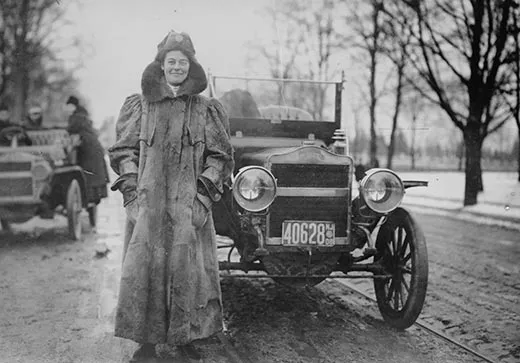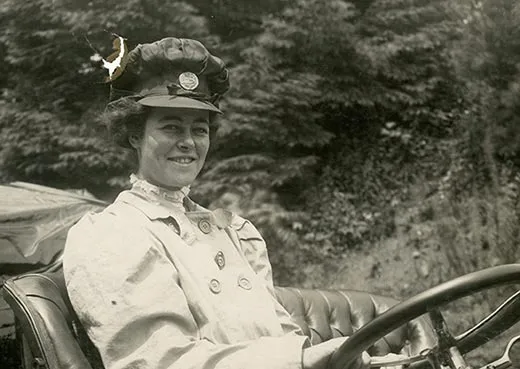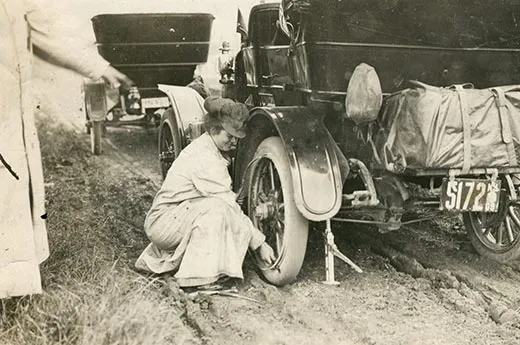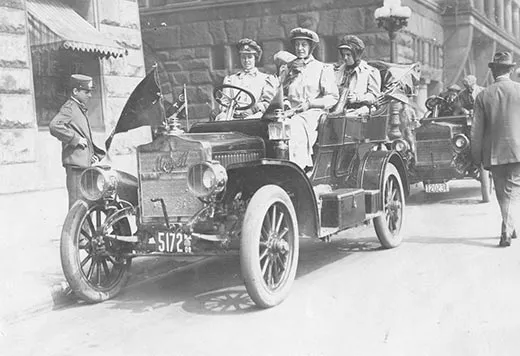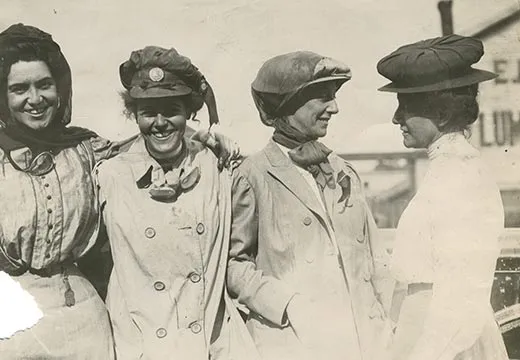Alice Ramsey’s Historic Cross-Country Drive
In 1909, 22-year-old Alice Ramsey made history as the first woman to drive across the United States
/https://tf-cmsv2-smithsonianmag-media.s3.amazonaws.com/filer/Alice-Ramsey-631.jpg)
On June 9, 1909, in a rain drenched New York City, a crowd of wet photographers gathered at 1930 Broadway to snap pictures of an “automobile” and the four poncho-cloaked women within. The car itself was a dark-green, four-cylinder, 30-horsepower 1909 Maxwell DA, a touring car with two bench seats and a removable pantasote roof. But the cameras focused particular attention on the woman in the driver’s seat, 22-year-old Alice Ramsey. Just over five feet tall, with dark hair below her rubber helmet and visor, she posed until she could stand it no more; then she kissed her husband goodbye and cranked the motor to start the car’s engine. Off the Maxwell drove with a clank of tire chains, westward on a transcontinental crusade: the first all-female, cross-country road trip.
Ramsey hadn’t set out to make feminist history—ironically, two men laid the groundwork for her trip. Her husband set the wheels in motion the previous year, after a “monster” scared Ramsey’s horse when it sped past at 30 miles per hour; John Rathbone Ramsey thought it wise to purchase his wife a car as well. Ramsey took to driving, and that summer she clocked 6,000 miles traveling the mostly dirt “highways” near her Hackensack, New Jersey, home. When she entered an endurance drive, a 200-mile trip to and from Montauk, a man representing automaker Maxwell-Briscoe Company marveled at her driving prowess and came up with an idea. He proposed an all-expenses-paid trip, courtesy of the company, if Ramsey showed the world that a Maxwell could take anyone—even a woman driver—all the way across America.
To accompany her on the trip, Ramsey brought Nettie Powell and Margaret Atwood, her “conservative” sisters-in-law, both in their 40s; and Hermine Jahns, an enthusiastic 16-year-old friend. Ramsey and her three passengers had to learn the basics of car safety, wear hats and goggles, and cover their long dresses with dusters to protect themselves from dirt and dust. They spent nights at hotels and ate restaurant food and much-appreciated home-cooked meals, when possible; at other times, they picnicked on bread or, during one early morning stop in Utah, a breakfast of coffee, corn flakes, and canned tomatoes scrounged from a general store.
Soon the Maxwell reached Ohio; driving the Cleveland Highway they set a personal best, attaining “the terrific speed of 42 miles per hour.” Though the Maxwell-Briscoe Company would publish an ad upon arrival stating that the group traveled “without a particle of car trouble,” this was far from the truth. Already, Ramsey had fixed at least one tire blowout and had called for a mechanic to repair a coil in Syracuse, waiting near their car as someone in the crowd cried “Get a horse!” as Ramsey would recall.
In the Midwest, the car ran out of gas. The women had forgotten to check the tank, a process that required the driver and her seatmate to leave the car, remove the front seat cushion, and stick a ruler into the Maxwell’s specially fitted 20-gallon fuel tank. The next day, moving through mud in low gear overworked the car, and the transmission needed water. There was no extra on board, so Powell and Atwood proved their mettle by using their toothbrush and toiletries holders—made of cut-glass and sterling silver—to transport water ounce by ounce from road-side ditches to the radiator.
Perhaps certain car problems were unavoidable. After all, the trip put the Maxwell to the test for long days on difficult roads. Iowa’s weather posed particular challenges. There was “no gumbo too thick” for the Maxwell, said its manufacturers, but some potholed, muddy roads proved practically impassable for the tread-less tires. It was slow-moving and, in one case, no-moving: the women slept beside an overflowed creek until the water receded enough that they could ford it. They persevered through the region, taking 13 days to conquer 360 miles (and relying on horses for towing at times!).
Because the automobile industry was yet in its infancy, America’s roads were not yet designed for long-distance driving. For navigation, Ramsey relied on the Blue Book series of automotive guides, which gave directions using landmarks. But sometimes the route changed faster than the books. The women struggled to find a “yellow house and barn” at which they were supposed to turn left; a horse-loyal farmer had deliberately foiled drivers by repainting in green. Worse, there were no books for regions west of the Mississippi River. The Maxwell took worn routes, at crossroads following the telegraph poles “with the greatest number of wires,” according to Ramsey. On certain days, the Maxwell-Briscoe Company hired pilot cars familiar with the area to lead them. Even so, the party sometimes hit a dead end at a mine or sandpit and had to backtrack for miles.
Beyond the physical triumph of survival, pride also came from the public’s enthusiastic support. Locals rode horses for miles and waited by roadsides for hours to catch a glimpse of the Ramsey team. Ramsey recalled a Western Union telegraph boy in Chicago who stared “dumbfounded” at the women. Though it was now typical to see females travel short distances, a cross-country trip had been tried only a handful of times and never accomplished. Only six years had passed since Dr. Horatio Nelson Jackson’s 1903 drive marked the first male cross-country success.
When they entered California, Ramsey and her passengers marveled at the sugar pines and redwoods, of which “None of us had ever seen the like.” The same could be said for the media’s reaction upon their arrival. “PRETTY WOMEN MOTORISTS ARRIVE AFTER TRIP ACROSS THE CONTINENT” the San Francisco Chronicle proclaimed. “The car for a lady to drive,” self-congratulated the Maxwell-Briscoe Company. It was August 7, 1909, and they had made it. In total, the trip had taken 59 days and covered 3,800 miles.
After her brief bout with fame, Ramsey returned to New Jersey by train, where she resumed a relatively low-key profile raising two children. She continued her cross-country drives, losing count after her thirtieth. In 1960, the Automobile Manufacturers Association named her their “First Lady of Automotive Travel” for her trek across a “trackless land.” The next year Ramsey published Veil, Duster, and Tire Iron, a chronicle of the 1909 trip. She later drove five of the six passes of the Swiss Alps, giving up the last under doctor’s orders regarding her pacemaker. Ramsey died in 1983. The achievements of the Maxwell-Briscoe Company were shorter-lived; Chrysler absorbed the company in 1926.
In 1999, when Alaska Airlines Magazine printed an article about the 90th anniversary of Ramsey’s trip, the story inspired car buff Richard Anderson and Emily, his daughter. On June 9, 2009, Anderson, a 37-year-old, Seattle-based event manager and new mother, will commemorate the drive’s centennial by making her own cross-country trip in a 1909 Maxwell rebuilt by her father.
Learning to drive the Maxwell has been challenging at times. Anderson often misses second gear and struggles with the clutch and brake, which use the same pedal, and she has been known to stall mid-intersection. But she calls her challenges “easy, when I consider what [Alice Ramsey] had to face.” There is one trial that, if accomplished, might impress even Ramsey: wearing period garb, Anderson and co-pilot Christie Catania will begin their trip by navigating through Manhattan on a weekday morning during rush hour!
Richard Anderson has already had to explain himself and his seatbelt-free car to one concerned police officer during a practice drive. Whether the car will also face flack for its lack of blinkers (they will use hand signals to turn) or slow pace (the Maxwell still maxes out near 40 mph) remains to be seen. But if the precedent set by Ramsey holds, there will be no problem with the authorities: throughout her entire driving career, she received just one ticket. She had made an illegal U-turn—though not, of course, on her famed cross-country trip—in 1909, Ramsey forged only straight ahead.
